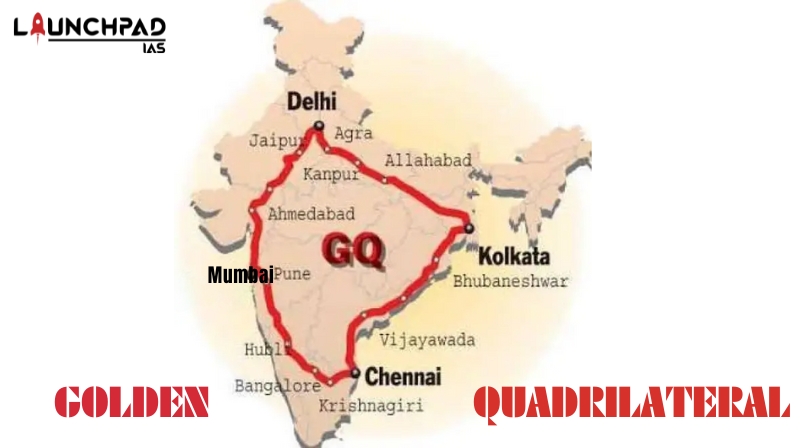About Golden Quadrilateral
- Golden Quadrilateral is a highway network that connects Delhi, Mumbai, Kolkata, and Chennai, thereby uniting India’s major industrial, agricultural, and cultural centers.
- The project began in 2001.
- It was Phase 1 of the larger National Highway Development Project, which was initiated by the same administration in 1998.
- The National Highways Authority of India (NHAI), which is part of the Ministry of Road, Transport, and Highways, is in charge of it.
- When it was completed, the Golden Quadrilateral, which consisted of 5,846 km (3,633 mi) of four/six lane express roads, was the biggest highway project in India and the sixth-longest in the world.
- It is so named because it connects Delhi, Mumbai, Kolkata, and Chennai, forming a type of quadrilateral.
- The fundamental goal of these superhighways is to shorten the distance and time connecting India’s four megacities.
- This project includes the North-South corridor connecting Srinagar (Jammu and Kashmir) and Kanyakumari (Tamil Nadu), as well as the East-West corridor connecting Silchar (Assam) and Porbandar (Gujarat).
- The network also connects other key metropolises such as Pune, Ahmedabad, Jaipur, Kanpur, Surat in the north and Bengaluru, Visakhapatnam, and Bhubaneswar in the south.
- The increased speed limits were possible as a result of the systematic and planned strengthening of the track and its infrastructure by removing bottlenecks in these sections at a rapid pace.
- This featured stronger rails, the installation of 260-meter-long welded rail panels, and the upgrading of bends and slopes, among other things.
- The maximum speed restrictions on the High-Density Network (HDN) between Secunderabad and Kazipet (132 km) have already been increased to 130 kmph.
Benefits
- Increases the speed of transportation between major cities and ports.
- Connects key agricultural, industrial, and cultural centers of India.
- Allows for more efficient transportation of products and people around the country; enables industrial growth and employment creation in smaller towns through access to diverse markets.
- Farmers may transport their goods to large cities and towns for sale and export, resulting in reduced waste and spoilage.
- More economic growth from construction, as well as indirect demand for steel, cement, and other building materials.
- Giving a boost to truck transportation across India.
- Reduced waste in the agricultural industry, as well as lower vehicle running costs and time.
- For a vast country like India to preserve national cohesiveness and socioeconomic progress, an effective road network is important.
- It encourages fast industrialization by facilitating the cheaper and more efficient flow of products, people, and ideas across borders.
- The flexibility and mobility of the workforce are influenced by road infrastructure.
- Rapid urbanization and population changes in India necessitate an increase in road infrastructure expenditure.


